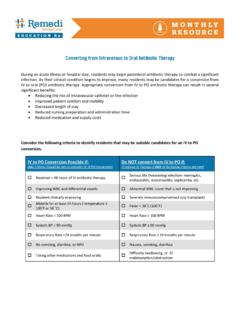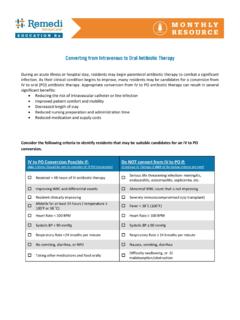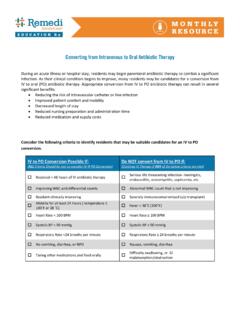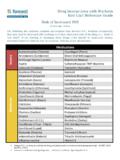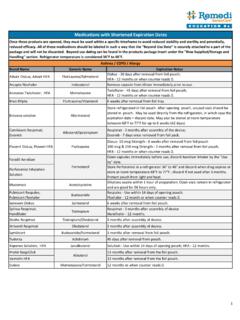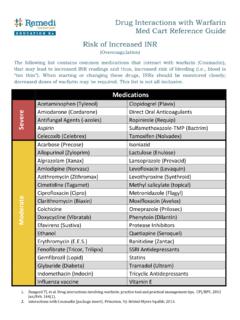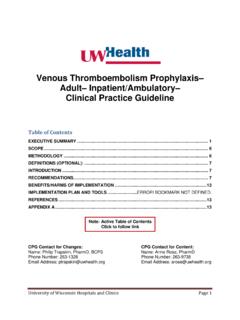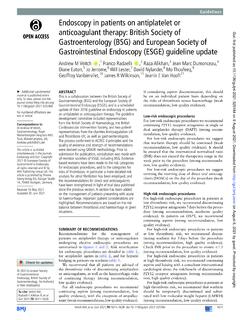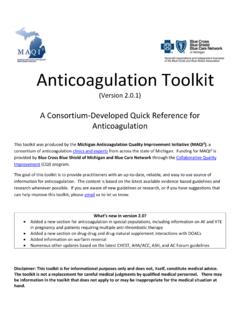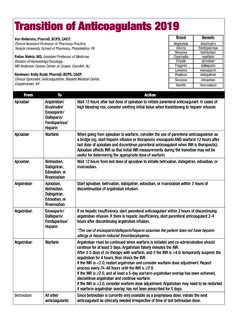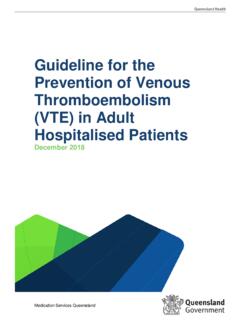Transcription of Oral Anticoagulant Comparison Chart - Remedi SeniorCare
1 oral Anticoagulant Comparison Chart venous thromboembolism (VTE) is manifested as Deep venous Thrombosis (DVT) and Pulmonary Embolism (PE). VTE prophylaxis and treatment is critical to survival and the incidence of VTE practically doubles for every decade over age 50 with a slightly higher incidence in males (1). Anticoagulant medications are the mainstay drugs used to treat VTE, and several numerous oral anticoagulants have entered the market recently. Three newer drugs in particular are being prescribed with increased frequency in the Long Term Care environment: Pradaxa , Xarelto , and Eliquis . The primary advantage of all three medications is that there is no requirement for routine blood monitoring, as there is with warfarin (Coumadin).
2 Cost of the newer medications is higher than warfarin, but due in part to risk reductions in lab monitoring, reduced frequency of transcription errors, and filling and administration errors, many organizations and insurance companies are adding the new drugs to their formularies. This Monthly Resource provides a comparative Chart of these newer Anticoagulant medications, as well as warfarin and enoxaparin, on how to effectively: Distinguish between anticoagulants Understand their approved uses Monitor effectively Outline potential adverse effects If you have any questions, please do not hesitate to contact your Remedi SeniorCare pharmacist. Reference: , et al.
3 Pharmacotherapy. A Pathophysiologic Approach 7th ed. McGraw Hill Companies. New York. 2008. p 331 Anticoagulant Comparison 2015 Drug Enoxaparin (Lovenox )1 Warfarin2 Rivaroxaban (Xarelto )3 Dabigatran (Pradaxa )4 Apixaban (Eliquis )5 Indications * prophylaxis of DVT *Treatment of DVT * prophylaxis of Ischemic Complications of UA and Non-Q-wave MI *Treatment of acute STEMI * prophylaxis /treatment of VTE * prophylaxis /treatment of thromboembolic complications of AF and CVR *Reduction in risk of death, recurrent MI, and thromboembolic events (stroke/systemic embolization) post-MI *Post-operative prophylaxis of VTE following knee or hip replacement surgery *Prevention of stroke and systemic embolism in patient with nonvalvular AF *Treatment of VTE *Prevent recurrent VTE *Prevention of stroke and systemic embolism in patient with nonvalvular AF *Treatment of active DVT/PE in patients treated with IV Anticoagulant for 5-10 days *Treatment of recurrent DVT/PE *Prevention of stroke and systemic embolism in patient with nonvalvular AF *Prohpylaxis of DVT/PE in patients who have undergone hip or knee replacement surgery *Treatment of DVT/PE both current and recurrent Mechanism of Action Inhibits Clotting Factors IIa and Xa Inhibits VKORC-1.
4 Inhibits synthesis of Clotting Factors II, VII, IX, X and Proteins C and S Inhibits Clotting Factor Xa Direct Thrombin Inhibitor (Clotting Factor II) Inhibits Clotting Factor Xa Dosing prophylaxis : Hip: 30 mg twice daily or 40 mg daily Knee: 30 mg twice daily Treatment: 1 mg/kg twice daily or mg/kg daily Individualized to patient VTE Treatment: 15 mg twice daily with food for 3 weeks, then 20 mg daily with food. Prevention of Recurrence: 20 mg daily with food Nonvalvular AF: 20 mg daily with evening meal Post-operative prophylaxis : Knee: 10 mg daily for 12-14 days Hip: 10 mg daily for 35 days 150 mg twice daily 5 mg twice daily In patients with 2 of the following characteristics: Age >80 Weight <60 kg SCr > mg/dL Reduce dose to : mg twice daily Dosing Adjustments For CrCl < 30 mL/min * prophylaxis : 30 mg once daily *Treatment: 1 mg/kg once daily *No adjustments for renal or hepatic insufficiency Indication Dependent: Nonvalvular AF: CrCl <50: 15 mg daily CrCl < 15: Avoid use Postop prophylaxis , and treatment of VTE: CrCl < 30.
5 Avoid use CrCl 15 30 mL/min: 75 mg twice daily CrCl <15 or dialysis: Avoid use CrCl 15 30 mL/min: mg twice daily CrCl <15 or dialysis: Avoid use Anticoagulant Comparison 2015 Drug Enoxaparin (Lovenox )1 Warfarin2 Rivaroxaban (Xarelto )3 Dabigatran (Pradaxa )4 Apixaban (Eliquis )5 Adverse Effects *Bleeding *Anemia *Thrombocytopenia *Elevated Transaminases *Diarrhea *Nausea *Bleeding *Hemorrhage *Tissue Necrosis *Intraocular Hemorrhage *Cholesterol embolus syndrome *Gangrenous disorder *Bleeding *Bruising *Peripheral Edema *Abdominal Pain *Diarrhea *Extremity Pain *Thrombocytopenia *Hematuria *Bleeding *Dyspepsia *Gastritis-like symptoms *Urticaria *Rash *Pruritis *Bleeding *Bruising *Nausea *Anemia *Post-procedural hemorrhage *GGT and transaminases increased Monitoring Parameters *Symptoms of Bleeding *CBC *Liver Function Tests *Anti-Xa Levels *PT/INR *CBC *Liver Function Tests *Symptoms of Bleeding *CBC with Differential *Renal/Hepatic
6 Function *Symptoms of Bleeding *Anti-Xa levels *Renal Function *Symptoms of Bleeding *CBC with Differential *Renal Function *Renal/Hepatic function *Symptoms of Bleeding Drug Interactions *Anticoagulants *Platelet Inhibitors *NSAIDs *Dipyridamole *Anticoagulants *Platelet Inhibitors *NSAIDs *SSRIs/SNRIs *Antifungals (Ketoconazole, etc)/Antiretrovirals *Diltiazem/Verapamil *Amiodarone *Bactrim/Fluoroquinolones *Anticoagulants *Platelet Inhibitors *Macrolide Antibiotics *Prostacyclin Analogues *NSAIDs *Diltiazem/Verapamil *Rifampin/Phenytoin *Amiodarone/ Dronedarone *Ranolazine/Quinidine *Anticoagulants *Platelet Inhibitors *Rifampin *Dronedarone/ Amiodarone *Diltiazem/Verapamil *Quinidine *Clarithromycin *Anticoagulants *Platelet Inhibitors *NSAIDs *Dipyridamole *Ritonavir *Antifungal Agents (Ketoconazole, Posaconazole,etc)
7 Contra-indications *Active Major Bleeding *Thrombocytopenia with positive antiplatelet antibody *Hypersensitivity *Hypersensitivity *Hemorrhagic Tendencies *Aneurysms *Recent or potential CNS or Eye surgery *Blood Dyscrasias *Pericarditis *Pleural Effusions *Pregnancy *Pre-eclampsia/Eclampsia *Hypersensitivity *Active pathological bleeding *Hypersensitivity *Active pathological bleeding *Mechanical prosthetic heart valve *Hypersensitivity *Clinically-significant active bleeding *Spontaneous impairment of homeostasis *hepatic disease with coagulopathy and increased bleeding risk *Concomitant systemic treatment with strong inhibitors of CYP3A4 and p-glycoprotein References [package insert].
8 2. Warfarin [package insert]. 3. Rivaroxaban [package insert]. [package insert]. 5. Apixaban [package insert]. 6. Guyatt GH, Akl EA, Crowther M, et al. Antithrombotic therapy and prevention of thrombosis, 9th edition: American college of chest physicians evidence-based clinical practice guidelines. CHEST 2012;141(2):7S-47S.
